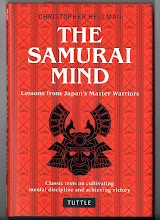 |
| Advertising for the Ikeda-ya on Sanjo Street |
Japan, and particularly Kyoto, it seems, is an extremely information rich environment: walking through the streets, on odd corners, outside temples or next to bridges, you can often see information boards or stone markers to inform passers-by of the historical importance of each location, as well as a huge number and variety of notices everywhere concerned with more immediate details of everyday life.
For non-Japanese, however, the difficulties of accessing this information (which means reading Japanese), makes the experience quite different - there is so little you can actually understand, and much of that is without a familiar context , even if you have some knowledge of the history, that many give up even trying. It's enough to discourage even a well-developed sense of curiosity.
But over the years since I came here, the accessibility of information, both in Japanese and English, has improved enormously. This is partly due to the advance of technology, and the proliferation of on-line sources, but also to the increasing presence of information at street level.
 |
| You can just see the sword cuts in the dark area |
One such that particularly piqued my interest are the sword cuts on one of the bronze finials of Sanjo Bridge.
The finials themselves (giboshi) are, all save one, the originals from when Hideyoshi had the bridge built in 1590, as indeed are some of the stone pillars (on the south side) on which the bridge stands. Another one of these pillars is now outside Starbucks at the northwest end of the bridge. Civil engineering has never been a particular interest of mine but, like almost any subject, the more you look into it, the more interesting it becomes.
Of course, what I was really interested in were those sword cuts. They date, apparently, from the famous Ikedaya incident which occurred just along the street in 1864. I used to work in the building just next to the site of the incident, which was, in those days, marked by a small stone pillar in front of a pachinko parlor. This was in the days when the British Council and Japan Research Foundation libraries, and one or two bookshops, together with the occasional article in Kyoto Visitors Guide constituted the bulk of my research resources, and I was pretty happy to find out that I was working right next to the Ikedaya, site of one of the most famous engagements of the Bakumatsu period.
For those of you unfamiliar with it, this was when the Shinsengumi, a para-military force supporting the ailing government, mounted a surprise attack on a group of pro-Imperial plotters, many from the Choshu Domain, who were meeting at the inn. The battle itself lasted for a couple of hours, and eventually involved some 60 or so people. At first, however, the Shinsengumi members were outnumbered - 9 of them, under their leader Kondo Isami, attacked the plotters, who numbered about 30. Later reinforcements equalled the numbers. Largely confined to the Ikedaya inn itself, the fighting spilled onto the streets as the plotters tried to escape. Some, it seems, made it as far as Sanjo Bridge, hence the scars on the bridge. It was a hard fought battle, but the Shinsengumi lost only 3 men (2 of whom died of their wounds), compared to 8 on the other side, and more than 20 taken prisoner.
For anyone who wants to have a look for themselves, the sword marks are on the second post from the west, on the south side.
And the Ikeda-ya? Now it is an izakaya, with the front made up in period style. A notice-board in front gives an account of the affair, and you can often see interested groups of tourists stopping outside to read. It is, of course, in Japanese.










